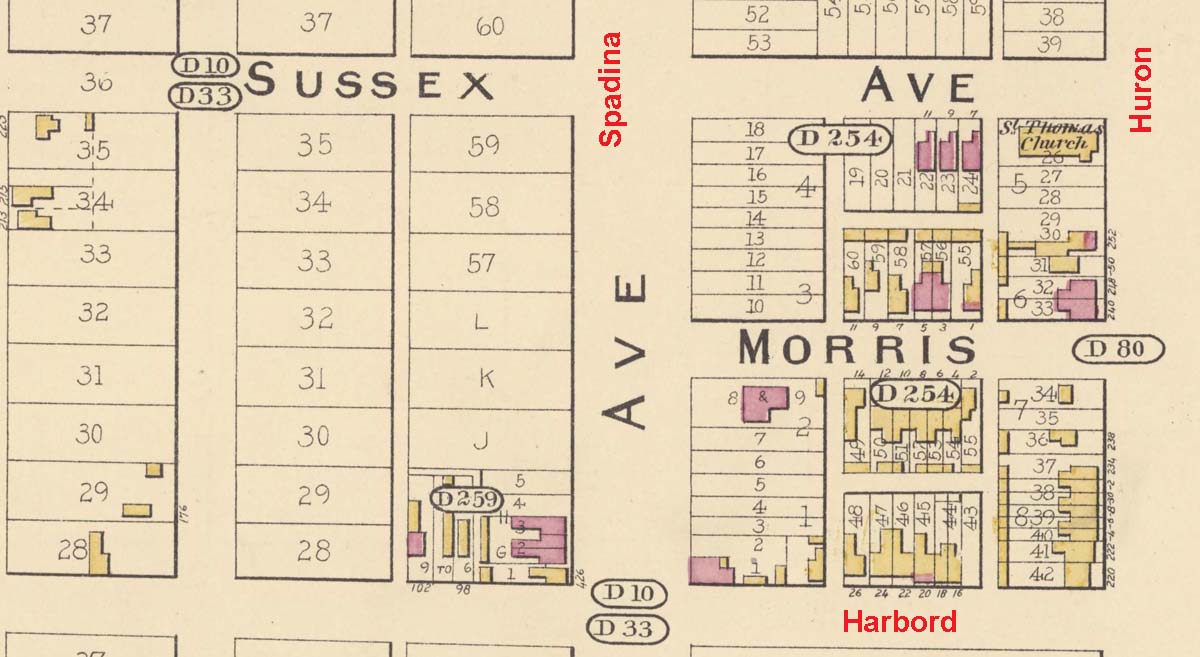City heritage planners have recommended three Victorian houses owned by the University of Toronto (U of T) in the Huron-Sussex neighbourhood be given heritage designation to protect from demolition or significant change.
The houses, located at 29, 31 and 33 Sussex Avenue near Huron Street, were built in 1879 and are the earliest surviving houses in the neighbourhood.
On Wednesday, the city's preservation board voted to ask heritage staff about whether the interior detail of the houses should also be protected. The board will next meet on Jan. 31 to make a decision.
The Huron-Sussex neighbourhood is largely owned by the university, due to a series of expropriations that took place decades ago.
In 2020, U of T owned 88 residential addresses in the Huron-Sussex neighbourhood, containing a total of 162 rental units. Many of the properties are now used for housing faculty.
"The University of Toronto used to go door to door with lawyers in the 1960s and 1970s and threaten the people in these houses to sell their houses or they would get an expropriation order," preservation board member Adam Wynne told TorontoToday.
"There are a large number of people in their 80s and 90s who actually sold to the University of Toronto back in the ‘60s and ‘70s,” Wynne said. “The condition was that you would pay very cheap rent for the house, and [U of T] would let them live there until they die. But after they died, the university could do whatever they want with the property."
Preservationists like Wynne argue the houses need to be protected from the university.
He pointed to the demolition of a row of Victorian cottages on Harbord Street, on the western side of the campus, as a warning sign about the fate of the Huron-Sussex properties. The cottages were torn down to make way for a university residence building.
Julie Mathien, a former president of the Huron-Sussex Residents' Association, said the three Sussex Avenue houses are not the only properties at risk.
Mathien said a planned U of T development on the southeast corner of Bloor Street West and Spadina Avenue would also involve demolishing all the Victorian houses situated on the north side of Washington Street, a block away from Sussex Avenue.
Both Mathien and Wynne acknowledged that heritage preservation must also be considered alongside the city’s need for more housing.
"We're not in the dark ages," Mathien said. "We know that density has to increase."
On the other hand, the university — armed with legal powers of expropriation — has historically taken a heavy-handed approach to its surrounding neighbourhoods.
"The city has recognized [Huron-Sussex] as an area of special identity in order to maintain it and not have it flattened as a result of university development," Mathien said.
She said other “vibrant communities” in the area around U of T didn’t share the same luck, and were destroyed in the ‘50s, ‘60s and ‘70s.
"We’re the last holdout, and that's because the university ran out of money for that kind of construction,” Mathien said.
U of T said it supports the heritage designation.
"The properties at 29, 31 and 33 Sussex Avenue are part of the University of Toronto’s Huron-Sussex Community, which provides housing for new faculty members and students with families," Christine Burke, U of T's assistant vice-president of university planning, said in a statement.
"The university was pleased to work with City of Toronto staff in bringing forward the designation of these houses and is supportive of the designation as recommended by staff in their report,” the statement continued. “The university is a proud and successful steward of numerous heritage properties within and around the St. George campus."
The university did not respond directly to TorontoToday questions about future plans for the three buildings.
In an effort to prove why heritage status is necessary, Wynne pointed to a deadline created by a provincial law under Bill 23 that will see some buildings lose heritage status in the near future
Under Bill 23, properties that are categorized as “listed” — a much weaker form of heritage preservation than a full designation — can only hold that status for two years. After that, the property will lose its listed status if it is not fully designated. The property is then ineligible to regain heritage status for another five years.
Toronto has about 3,800 listed historic properties, some of which have had that status for nearly 50 years.
The houses at 29, 31 and 33 Sussex Avenue are already considered listed historic properties.
Wynne and Mathien said the Huron-Sussex area was a buzzing cultural centre in the late '60s and early '70s.
“At 24 Sussex Ave., Margaret Atwood published her first book," Wynne said. "House of Anansi Press started at the corner of Sussex and Spadina. Dennis Lee wrote Alligator Pie, one of Canada's best known children's books, in 29 Sussex in the 1960s."
29 Sussex Ave., one of the houses named in the heritage application, is now untenanted and appeared to be in shabby condition when a TorontoToday reporter visited this week.
"When the longtime owner sold the property in 2013, a developer bought it,” Wynne explained.
Wynne said the developer tried to demolish the property but was unsuccessful because of the home’s listed historic status. The house was gutted, and then was left neglected, he said. It was later sold to the university.
"Change happens, and nothing is sacrosanct," Mathien said. "But when you have three notable properties like this, you want to save them as a part of a part of the historical warp and weft of Toronto."
29, 31 and 33 Sussex appear as 22-24 Sussex in this 1885 map of Toronto.

